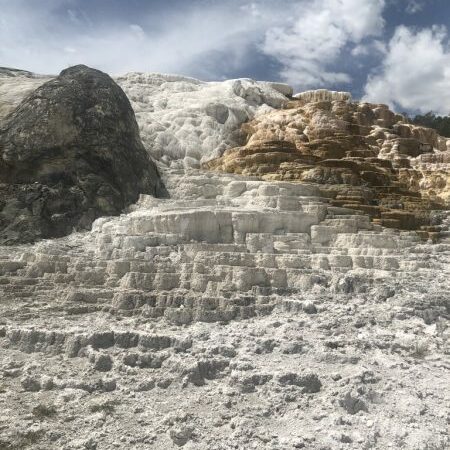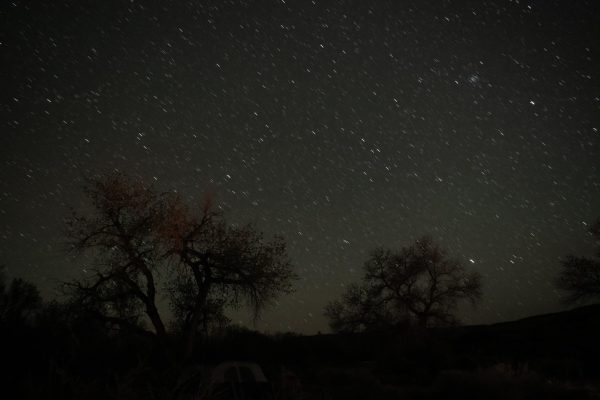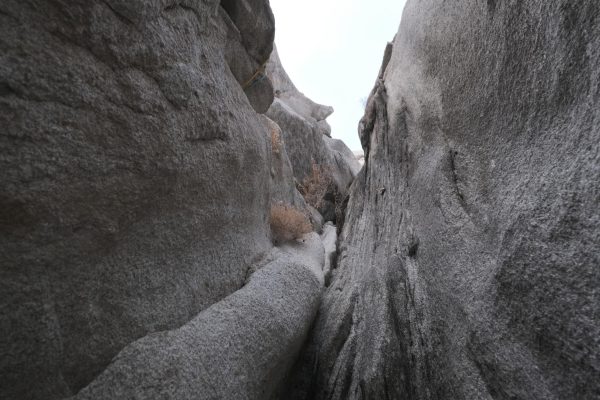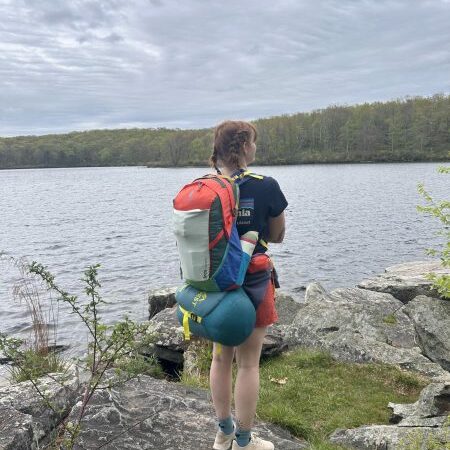Flying Fires and Jumping Smoke
Storm clouds glide over mountain tops across the valley. Animals take cover under the canopy of thick, dense forest. Thunder rumbles through the air. Dry lightning cracks across the sky. A spark illuminates the dark night, an orange glow starts to grow. Wood crackles, smoke billows, a pine tree catches fire. The Payette National Forest starts to burn.
Panic rises as alarms sound. Nature cries out for help, to a sky fresh out of tears to shed. With the weather on hiatus, it’s up to humanity to save the wild. Luckily for us, there is a force ready, waiting for this exact stroke of misfortune to occur. Bags are pre-packed, equipment has been double, triple checked, training has been completed, scenarios practiced … prepared is an understatement.
Highly-skilled individuals arrive on the scene in no time. They are met with clouds of smoke, heat waves emitting from the flames of the already roaring fire. The scene is surveyed, orders spoken, and with that, bodies start to fall from the sky.
No, no that can’t be right. Fire burns and the result is humans plummeting towards the said fire? But where did they come from? Why is this happening?
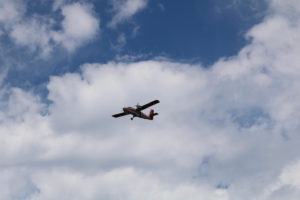 The explanation is quite simple actually. They came from the Twin Otter airplane that can be spotted flying above the smoke clouds. And this is happening because these people descending from the sky are nature’s answered prayer. They are smokejumpers.
The explanation is quite simple actually. They came from the Twin Otter airplane that can be spotted flying above the smoke clouds. And this is happening because these people descending from the sky are nature’s answered prayer. They are smokejumpers.
The United States Forest Service is a government agency and a branch of the Department of Agriculture. It is responsible for 193 million acres of National Forests and Grasslands across the country. A major section of the organization is wildland firefighting, and that’s where smokejumpers come in.
Being from the small mountain town of McCall in the Northern part of Idaho, I’ve always been very aware of the Forest Service and smokejumping. As home to one of the bases, smokejumping, and in turn, wildfires, are woven so tightly into the fabric of our little town that if you’re a local, you just know. I’ve been familiar with smokejumpers for as long as I can remember, though I just learned the true complexities of the job this summer. I also came to realize that not a lot of people even know what a smokejumper is.
With that being said, a smokejumper is an occupation category under wildland fire suppression. Smokejumpers are people who travel to fires across the nation, via airplane, and parachute as close to the fire as they can get in order to do what they are trained to do, to “catch” the fire. Retired smokejumper and professor of sociology Patrick Withen explained that smokejumpers perform a “rapid attack on small fires and bring in a tremendous amount of expertise to a fire.” Starting in 1939, smokejumping has played a key role in wildland firefighting. There are about 400 smokejumpers employed across seven bases spread throughout Idaho, Montana, Oregon, Washington, California, and Alaska. Because smokejumpers are working in public lands, they have to get “invited” to a fire by a local forest or base. Sometimes there are smokejumpers from multiple bases at one fire.
Even with my knowledge, as little as it is, I was shocked to learn that there are only nine smokejumping bases in the entire US, with seven managed by the Forest Service and two managed by the Bureau of Land Management (BLM). As large and dense as I know some of our forests to be, this seems like a considerably small resource to cover that much land. But they do it, and they do it well. Once the plane is headed toward a fire, loaded with smokejumpers (the amount varies depending on the size of the fire) and necessary cargo/equipment, the work begins. First, the spotter directs the pilot to the jump spot, because the pilot can’t see the target once the plane is above it. Then the spotter will tell the jumpers the best time to jump in order to have the highest probability of landing on the jump site, which is awfully close to the flames. This natural disaster is their office. Sounds relaxing, right?

Smokejumpers used to use “round” parachutes and would jump from 1,500 feet, but the Forest Service switched to a ram-air or “square” canopy in 2015. The square parachutes allow jumpers to jump in higher winds and are more maneuverable than round canopies. They now jump from 3,000 feet. Jumpers want to land below the fire and into the wind, that way their landing is as slow and safe as possible. As soon as their feet hit the ground, they work to “build a line,” a separation of fuel from fire.
Steve Mello, an ex-marine and retired McCall smokejumper with a 34-year career under his belt, explains that the primary job of a smokejumper is to separate the fire from the fuel so that it can stop advancing. They use a variety of tools to do this, but the two most common are pulaskis (an ax and adze in one) and shovels. They use these tools to throw dirt and “scrape,” or move, fuel away from the fire. Anything to keep the fire line from moving forward. S. Mello emphasized that speed is the name of the game. “Our whole thing is: get to a fire and put it out before it gets big. Once it gets big, we’re just there hanging onto it until a team can come in and take it over.”
While smokejumpers are a key branch of the Forest Service for fighting fires, there are a number of other categories of wildland firefighters with specific training and functions. All equally important. Under the “on the ground firefighters” category, there are Engine crews, Handcrews, and Hotshots. Smokejumpers fall under the “in the air firefighters” category, along with Helitack crews. Engine crews are teams of two to ten people that spray water and foam on fires using specialized wildland fire engines, while Handcrews control wildfires by creating firelines with their 20-person team. They also burn out fire areas and “mop up,” or make a fire safe after it has been controlled. Mopping up also consists of reducing residual smoke from a fire.
Hotshots are the highest-skilled Handcrews and focus on an extended attack on a fire. They hike to large fires and tend to be assigned to the most challenging parts of a fire. They are almost working during fire season, which is roughly June through October, but preparation work begins in the spring months. Hotshots also have about 20 people on a team. Payette Mello, a former Hotshot in Cedar City, Utah who also worked on the Helitack crew in McCall, said that Hotshots “try to manage [wildfires] while they’re somewhat unmanageable.”
Helitack crews of about 14 people travel to fires via helicopter and can land near a fire to help with fire suppression or, if trained, can rappel from a hovering helicopter. They are used for a variety of missions, anything where a helicopter is needed. McCall is one of the four Helitack crews that also does short-haul medical extraction. These extractions are used to remove a critically injured person from an area that is inaccessible from the ground. They do this by repelling down and connecting the injured to a fixed line under the helicopter, where they lift them out and then transport them to receive definite medical care. “It’s a really diverse tool … aside from fire suppression, there’s so much you can do with a helicopter in such a big roadless area like we have on the Payette,” Johnny Edwards, an active McCall Helitack firefighter, said.
It takes special training to work in any of these wildland fire fields. Each field demands long hours, brutal conditions, a good amount of travel, and a lot of hard work. Wildland fire crews typically spend up to 14 consecutive days working on a fire before getting two days off. They work 16-hour days and many of the crews camp out near the fire. When they’re on a fire, it’s a cycle of work and sleep, that’s it.
As there are different categories of wildland firefighters, there are also different categories of wildland fires, ranging from Type One to Type Five. Type One fires are the biggest, most complicated fires, and they usually have political implications. Type Five fires are very small fires that don’t go past wildland. These fires require an initial attack, usually from smokejumpers, and fewer resources are required.
While lightning is a big natural contributor to wildfires, 85% of wildland fires in the US are caused by humans according to the NPS, the majority being unintentional. S. Mello and Withen both spoke of how wildfires are not the same as they used to be. Within their extensive careers, they witnessed the effects of the changing climate and increasingly extreme weather patterns. Withen said that he has noticed fewer smaller fires around the world nowadays. However, for the Payette National Forest, smaller fires are more common than the larger ones because a lot of the forest has burned up in previous years.
The Forest Service also organizes controlled burns of forests in the spring months to try to prevent future uncontained wildfires from starting. These burnings actually help to get rid of fuel in a responsible manner and save a lot of our forests, but sometimes they can get out of hand. “Mother Nature has all the control, we just have a plan,” S. Mello said.

Across the board, the people employed by the Forest Service are highly skilled and work extremely hard to protect our forests and keep our communities safe. Wildland firefighters are an immensely valuable asset for the preservation of nature. And now, if you ever see people jumping out of an airplane towards smoke, you can rest assured that it’s nothing to worry about.
Smokejumpers and wildland firefighters to the rescue!
The post Flying Fires and Jumping Smoke appeared first on Wasatch Magazine.
Source: https://wasatchmag.com/flying-fires-and-jumping-smoke/

